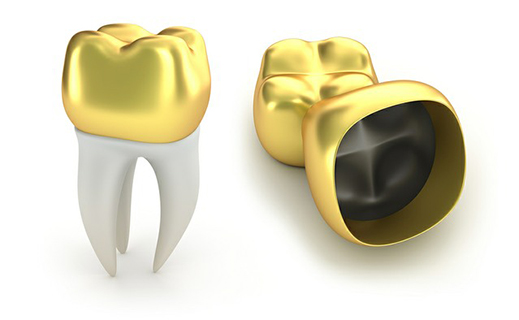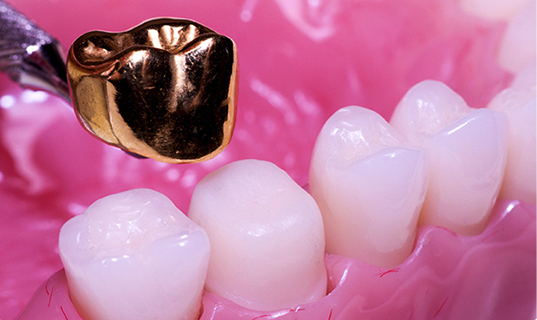What is a gold tooth crown?
The gold crown is the original type of dental crown and has had a long successful track record of use. It is not uncommon to see gold crowns placed by Dr. Hawryluk Sr. in the 1970s at our office still in perfect functioning condition. Some clinicians still regard gold as the dental material of choice. St. Lawrence Dentistry has a long history of placing gold crowns, although the use of them has greatly diminished. This is because new more modern crowns such as the Emax crown have largely taken their place. However, Drs Hawryluk and Taheri have not confined gold crown placement to a legacy procedure as there are some reasons why one may consider placing them.
Decay, fillings, trauma or even just normal chewing habits can make your teeth break down over time. A gold dental crown or a cap is a cover that is placed over a tooth to protect a weakened tooth from further fracturing or deteriorating. A gold crown could also be used to protect a tooth that has had a root canal. Lastly, a new gold crown is necessary to simply replace an old worn down or defective crown.

As a rule; the more precious metal or gold content in the metal the better the fit and better for the health of the gums around the crown. Keep in mind that fit is an important factor in sealing out the bacteria that tries to get between the crown and the tooth, possibly causing decay and premature failure of the crown.
A gold crown normally takes two visits for your dentist to complete. On your first visit, your dentist will shape and prepare the tooth so the crown can properly fit over it. Next, an impression of the tooth is taken and a temporary crown is inserted to protect the prepared tooth. This impression is then sent to a dental laboratory where a custom-fit permanent crown is made. On your second visit, the permanent crown is placed. If the fit and shape of the crown are excellent your dentist will proceed with permanently cementing it into place After the successful completion of the crown it is not uncommon to feel some discomfort, mild pain when you chew, or sensitivity to temperature changes for a few days. Also, if your newly cemented porcelain crown feels too tall or your bite doesn’t feel right, you should contact your dentist. Please keep in mind that the longevity of your crown depends in large part on the materials in the crown, as well as your oral hygiene, diet and the health of the supporting tooth and gums. It is important to maintain all of your teeth with proper brushing and flossing.

Gold crowns are not routinely used at St. Lawrence Dentistry because of the obvious disadvantage: It is gold colored and therefore it is not acceptable for use in an esthetic area. Even in non-esthetic areas, patients will still decline them due to their color. Therefore, gold crown use has been confined to limited specific situations where their use is indicated over other crowns.
The main advantage of a gold crown in the modern era is that it only requires .3-.5 mm of tooth preparation in order to make room for it. The more modern Emax crown requires 1-1.5mm of preparation which is obviously much more aggressive. The lesser amount of preparation means there is less chance of the dental pulp (tooth nerve) being irritated. This can avoid secondary procedures such as root canals.
If you would like to learn more about dental crowns and live in the Mississauga, Toronto, or Oakville area please give our office a call.



